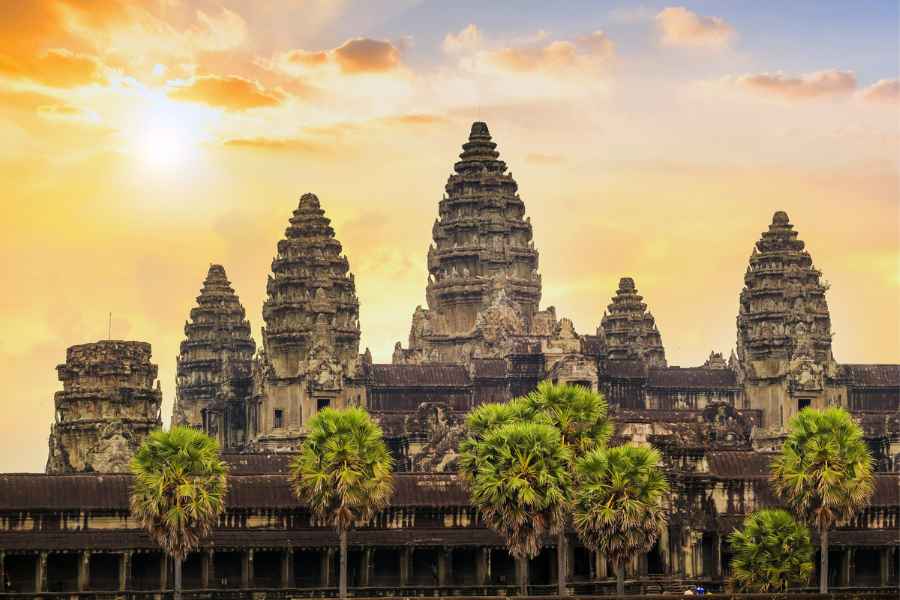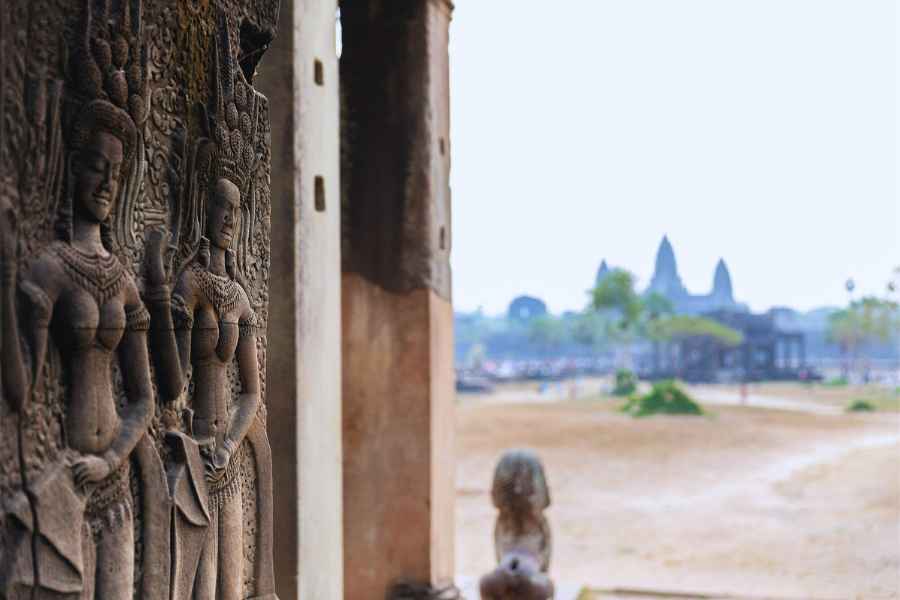Cultural and Historical Background of Angkor Wat
June 9, 2023

Table of Contents
Cultural and Historical Background of Angkor Wat
We dive deep into the history, art, and architecture of Angkor Wat to provide a richer perspective to tourists.
History of Angkor Wat
Angkor Wat was built in 802 CE as a Hindu temple for Lord Vishnu. It later transitioned into a Buddhist temple in the late 12th century. The carvings display ancient Indian mythology, Khmer life, and Buddhist doctrines.
The complex served as both a place of worship and political center. Showcasing grandeur during the peak of the Khmer Empire, its construction spanned centuries and involved thousands of Cambodians.
It’s possible that Angkor Wat collapsed due to ecological reasons, such as deforestation and soil erosion, rather than military invasion.
The legend of King Suryavarman II says he had a vision of Vishnu, prompting him to build this architectural masterpiece. However, the instructions on how to construct it were not included in the brochure!
Architecture of Angkor Wat
To better understand the Architecture of Angkor Wat with its Design and Layout, Building Materials and Techniques, and Religious Significance. Gain insight into the construction, symbolism, and function of this grand structure through the lens of its time in Southeast Asia.
Design and Layout
The Conceptualization and Arrangement of Angkor Wat
Angkor Wat’s design is a testimony to the grandeur of the Khmer Empire. Its mathematical precision, religious ideologies and vast grounds make it awe inspiring.
- Its structure reflects various cosmological interpretations, including orientation towards the cardinal points.
- The walls are adorned with intricate bas-reliefs, representing Hindu mythology.
- The central tower symbolizes Mount Meru, the home of Hindu gods.
- A complex water management system speaks of fertility and prosperity.
Angkor Wat’s architecture is notable for merging myth and science. Its upward-sloping galleries represent the planes to enlightenment.
To help visitors understand the temple’s symbolism, information boards are available. Conservation measures have been suggested to limit human contact and preserve the beauty for future generations. It’s amazing how sandstone and the ancient builders could achieve such timeless strength!
Building Materials and Techniques
Angkor Wat’s architecture was crafted using a range of natural resources. Check out the table below for details:
| Construction Materials | Building Techniques |
|---|---|
| Laterite | Sandstone quarrying |
| Sand | Cut-quarry mining |
| Gravel | Limestone paving |
| Earth | Interlocking bricks |
The temple also had complex hydraulic systems with reservoirs and canals, to help transport building materials. Astonishingly, the builders used no mortar or cement. They interlocked bricks together in a linear arrangement.
It’s worth visiting Angkor Wat and joining a guided tour to witness its intricate design and engineering feats. Seeing the carvings and stunning temple structures will make anyone feel religious, and may even make them wonder why their local place of worship doesn’t have a moat!

Religious Significance
Angkor Wat is a one-of-a-kind architectural wonder that’s of great spiritual importance to the Khmer Empire in present-day Cambodia. It began as a Hindu temple honoring the deity Vishnu. Later it was changed into a Buddhist temple. The sculptures and design reveal many mythic tales and it was a significant centre for rituals during the Khmer Empire.
The complex layout of Angkor Wat reflects the Khmer people’s cosmological beliefs. The tower in the middle is symbolic of Mount Meru, which is believed to be the centre of the universe in Hindu-Buddhist cosmology. The moat around it represents the world ocean, and the other towers stand for other planetary systems.
It’s remarkable that this construction from 900 years ago still serves its purpose. Tourists and religious pilgrims alike are amazed by the size and delicacy of this temple, making it an indispensable part of any trip to Cambodia.
Pro Tip: Make sure to take a guided tour to get a better understanding of the cultural and historical significance of Angkor Wat. Unveil the stunning artistry of Angkor Wat, where every detail speaks and each corner hides a secret waiting to be discovered.
Explore Angkor with Bayon Temple and the world-famous Ta Prohm (Tomb Raider) Temple
Art of Angkor Wat
To provide a richer perspective for tourists visiting Angkor Wat, the ‘Art of Angkor Wat’ section delves deep into the history, art, and architecture of the temple complex. We will introduce three sub-sections, namely ‘Sculptures and Bas-Reliefs’, ‘Painting and Murals’, and ‘Symbolism and Iconography’.
Sculptures and Bas-Reliefs
The incredible Art of Angkor Wat is incomplete without the unique details in the Sculptures and Bas-Reliefs. See below for some of the famous ones:
| Column 1 | Column 2 |
|---|---|
| Apsaras Dancing | Vishnu’s Assortment |
| Labors of Hercules | Churning of Milky Ocean |
The detailed works show divine scenes, mythical creatures, and historical events throughout the temple.
Don’t miss exploring these masterpieces to understand the artistry of Angkor Wat. Make sure to experience its beauty while you still can!
The art of Angkor Wat is so amazing, I’m sure even the artists wished they had Instagram filters to enhance their work!
Painting and Murals
The artwork of Angkor Wat is a critical part of the temple’s architecture. Paintings and murals depict mythical and historical stories in intricate detail. A table of these works would show their location, subject and style.
Outer gallery murals feature religious scenes, such as Avatars. Plant and insect pigments make them resilient to wear. Carvings are decorated with floral motifs, inspired by Indian aesthetics. Ancient methods, like beeswax coating, help paint last.
Environmental factors, such as humidity and acid rain, could cause these masterpieces to disappear. Don’t miss out on this Southeast Asian cultural center. Visit Angkor Wat and appreciate its symbolic icons!
Symbolism and Iconography
The art of Angkor Wat is a vivid representation of cultural and religious values. Its symbolism and iconography have a deep meaning with intricate designs, colors, and sculptures. Hindu and Buddhist symbols are used to portray divine beings, myths, and beliefs which impacted the Khmer Empire’s spiritual practices.
The myths all have their own meanings. For example, an 8-armed God Shiva symbolizes power, and Vishnu’s image portrays protection. Lotus flowers signify purity in Buddhism, and flags illustrate wind poise energizing life force. Such gorgeous detailing creates a sense of history from past beliefs.
Rulers commissioned personal shrines, too. This allowed more individual symbolism as they were given fewer restrictions than larger temple sponsorships. Objects like jewelry worn by gods, and carved edifices personifying legends were amongst the iconography visible at Angkor Wat’s art. Animals also embodied life cycles which were crucial in both religions.
The artists primarily served rulers and Gods. They had different techniques and styles passed down for generations. This has sustained modern-day Cambodian artistry with deep respect for culture.
Kwok Zakieng is a great example. He became one of Cambodia’s most celebrated contemporary artists despite the Khmer Rouge regime. He specialized in gold leaf painting with Buddhist iconography techniques found at Angkor Wat temples. His adherence to ancient craftsmanship still motivates young art graduates throughout the country.
Angkor Wat is not merely a tourist spot, it’s a symbol of the lasting cultural legacy of Southeast Asia.
Cultural Significance of Angkor Wat
To gain a deeper appreciation of the cultural significance of Angkor Wat, we delve into the influence it had on Khmer culture, the impact it had on Southeast Asia, and the legacy and preservation efforts surrounding this monumental structure.
Influence on Khmer Culture
Angkor Wat’s cultural significance has had a huge effect on the Khmer Civilization. It was a spiritual and political hub of the Khmer Empire, and showed off classical Khmer iconography and art. This inspired later building designs and influenced everyday life.
The temple complex was linked to other Southeast Asian states through trade. It sparked the growth of Buddhism, and over 20,000 temples were built throughout the region. The interest in Angkor Wat led to tourism, and a global appreciation for cultural preservation.
Angkor Wat wasn’t just a temple – it was a symbol of pride and power for the Khmer Empire. Jayavarman VII built several Buddhist temples within the complex, including Bayon Temple.
Even now, Angkor Wat’s cultural impact on Southeast Asia is still strong.
Impact on Southeast Asia
Angkor Wat had a huge influence on the culture of Southeast Asia. It spread Hinduism and Buddhism, and inspired art and architecture in Thailand, Laos, and Vietnam.
The temple is 402 acres large, and is full of intricate carvings and craftsmanship. It was a religious center for centuries, and a place for pilgrims, scholars, and artists. It became a UNESCO World Heritage Site in 1992.
It’s also a big tourist attraction, and has helped Cambodia’s economy by bringing in foreign investment. This has increased the nation’s GDP.
UNESCO’s world heritage committee says Angkor Wat is one of the biggest archaeological complexes in the world. Trying to preserve it is like trying to freeze time, only with more humidity and fewer popsicles.
Legacy and Preservation Efforts
Preserving and promoting Angkor Wat’s cultural heritage is a priority. Ongoing restoration projects help to keep the temples structurally sound and more accessible for visitors. Education and culture programs increase understanding of the site’s history and importance. This ensures future generations can appreciate its wonder.
Looting and damage by tourists has been reduced, due to archaeologists and government officials. Responsible tourism policies also bring economic benefits to Cambodia.
However, Angkor Wat faces challenges, such as natural wear and tear and environmental changes. Scholars work to maintain its sanctity through conservation techniques.
An inspiring story illustrates the importance of preserving and appreciating our heritage sites. A local villager found an ancient statue near his village, after decades of searching. Experts consulted on ways to save it. It was relocated to one of Koh Ker’s temples, 100 km away. This act reminds us to cherish our heritage sites and work together across generations.
Frequently Asked Questions
What is Angkor Wat?
Angkor Wat is a temple complex in Cambodia that was built in the early 12th century as a Hindu temple, but later transformed into a Buddhist temple. It is the largest religious monument in the world and a UNESCO World Heritage Site.
What is the cultural and historical significance of Angkor Wat?
Angkor Wat is a symbol of Cambodia’s cultural and religious heritage. It represents the pinnacle of the Khmer Empire’s artistic and architectural achievements, showcasing the civilization’s mastery of stone carving, engineering, and hydrology.
Who built Angkor Wat and why?
Angkor Wat was built during the reign of King Suryavarman II, who wanted to create a grand temple to honor Vishnu, a Hindu god. The temple was also intended to serve as a mausoleum for the king after his death.
What are the unique features of Angkor Wat?
Angkor Wat is renowned for its massive size and elaborate decorations, including intricate carvings, bas-reliefs, and sculptures. The temple also has a distinctive architectural style, with five towers resembling lotus buds and a central sanctuary surrounded by a moat and an outer wall.
What is the best time to visit Angkor Wat?
The best time to visit Angkor Wat is from November to February, when the weather is relatively cool and dry. However, this is also the peak tourist season, so be prepared for crowds and long lines.
How can I learn more about the history, art, and architecture of Angkor Wat?
You can take a guided tour of Angkor Wat or visit the nearby Angkor Archaeological Park Visitor Centre, which houses exhibits and multimedia displays about the Khmer Empire and Angkor Wat. You can also read books or watch documentaries about the temple’s history and culture.
Recent Post
Get 30% Discount Now
Categories
Guided Tours

Private Siem Reap Airport SAI Transfers – Siem Reap Airport Pick-up or Drop-off, Just for You!
From: 30$
Shared SAI Siem Reap Airport Transfer – We depart every 1 hour!
From: 9$
Private Full-Day Siem Reap to Koh Ker & Beng Mealea Temple Tour
From: 75$
2-Day Angkor Wat Sunrise & Banteay Srei Grand Tour – Small Group Tours
From: 30$
2-Day Angkor Wat Temple Sunset and Floating Village Tour
From: 40$
3-Day Angkor Wat Sunrise, Banteay Srei and Floating Villages Tour – Small Group Tours
From: 50$